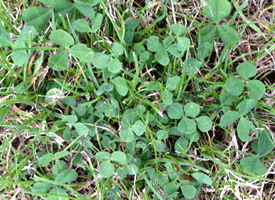A Plus Fertilizing
Residential and Commercial

If you are having an issue with this type of weed, please contact us to help you make the right choice for your property.
Weeds
White Clover
At one time clover was commonly added to seed mixes because it would grow where grass would struggle and it would provide green cover. This practice has since faded out due to the development of broad leaf weed controls.
- Perennial broad leaf weed.
- It emerges from dormancy in early spring.
- Extremely hard to control even with herbicides.
- Spreads by both root and seed which makes this weed very aggressive.
- Flowers are white to pink tinged and grow from long stems that usually rise above the leaves.
- During periods of drought or in early fall, white clover enters dormancy leaving brown patches in the lawn.
Interesting Facts
- White clover has the following vitamins and minerals:
- Vitamins, A,B,C,E
- Calcium
- Magnesium
- Chromium
- Potassium
- Dried flower heads and seed pods can be ground up into nutritious flour.
- Makes excellent forage for livestock but are hard for humans to digest without first cooking.
Prevention Tips
White clover can be very hard to prevent because its optimal growing conditions are the same as our grasses. Clover has a lot of great properties and for years it was added to grass seed mixes because of how it is a great source of nitrogen. Clover just like any other weed needs a place to invade.
- Proper mowing maintenance (such as having clean and sharp equipment).
- Fertilize at the proper time.
- Proper air circulation.
- Water deeply and infrequently. Weeds grow best when they are damp.
- Aerating and over seeding.
- The amount of sun or shade your lawn sees.
- What kind of soil you have and many other contributing factors are out of ones control such as “Mother Nature”.
We know all these factors can be a bit overwhelming, but each play a small part in a very large over-all picture.
« Back to Pests « Previous Weed – Next Weed »


Contact Us